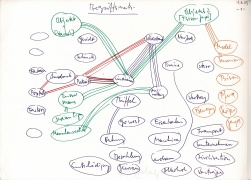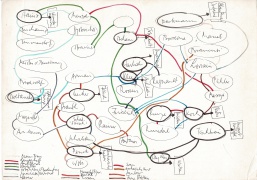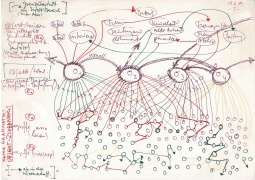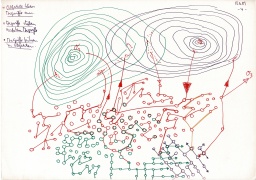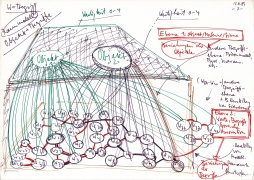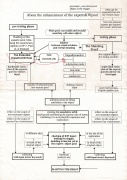Difference between revisions of "European MuseumsNetwork EMN"
(→Skizzen zum Netzwerk von Begriffen und Bildern) |
|||
| Line 136: | Line 136: | ||
Grundsätzliche Gedanken in der Anfangsphase des EMN: | Grundsätzliche Gedanken in der Anfangsphase des EMN: | ||
| − | <gallery> | + | <gallery mode="packed-hover"> |
Begriffsnetz.jpeg |Begriffsnetz | Begriffsnetz.jpeg |Begriffsnetz | ||
Farben statt Begriffe.jpeg|Farben statt Begriffe | Farben statt Begriffe.jpeg|Farben statt Begriffe | ||
| Line 145: | Line 145: | ||
</gallery> | </gallery> | ||
Enhancement of Keywords | Enhancement of Keywords | ||
| − | <gallery> | + | <gallery mode="packed-hover"> |
Keywords enhancement.jpeg | Keywords enhancement.jpeg | ||
</gallery> | </gallery> | ||
| − | Siehe auch hier: | + | Siehe auch hier:<br> |
| + | |||
[[Die Elektronische Kunst- und Wunderkammer]]<br> | [[Die Elektronische Kunst- und Wunderkammer]]<br> | ||
[[Art Network|Art Network/Kunst im Netzwerk]]<br> | [[Art Network|Art Network/Kunst im Netzwerk]]<br> | ||
| − | [[Main Page|Achim Lipp]] | + | [[Main Page|Achim Lipp]]<br> |
Revision as of 18:56, 19 November 2019
Contents
EIGHT EUROPEAN MUSEUMS TEAMING UP FOR EMN. And Where to Go From Now [1]
Achim Lipp, European Museums Network EMN, Winfried Schmitz-Esser, Germany, 1993
This paper is a report on the European Museums' Network (EMN), a telecommunications and multimedia project initiated and fostered under the EEC "RACE" programme in the past four years. It also includes the outcomes of the project and the lessons it taught us for future inter-museums' multimedia co-operation. Eight museums from eight European cities, namely Lisbon, Madrid, Paris, Den Haag, Bremen, Bremerhaven, Copenhagen and Hamburg, teamed up for the venture, plus four technical partners rooted in six European countries.
The objective
The objective of the project was to develop, within a time span of four years (1989 -1992) an interactive, networked multimedia system which complied with two main requirements:
• Guidance, information and animation for any interested museum "visitor" who may consult any single multimedia station installed at the site of one of the partner museums
• Set up of a common pool of selected multimedia representations of museum objects to be contributed by each of the partners, including a set of respective common rules of object description, and a common input routine, and multimedia input tools.
The eight Museums had been specialising in the areas of: Fine arts, ethnography, technology, archaeology and science. With the wealth of their contributions, they could be expected to constitute, in some way, a realistic profile of the creative and informative potential of European museums.
The challenge
The challenge was that any interested layman should be offered easy, uncomplicated access to the treasures of that collection, as well as orientational help and animation. He should be free to navigate through the documents, to discover themes and topics, and to visualise and elaborate on them in a widely unrestricted way together with related material collected from the most distant places, and of all kinds of sources.
The EMN project was ready for presentation to the public by mid 1992, and formally ended by the end of that same year. The experience gathered by the participating partners throughout Europe, and the response of both, the expert community and the general public, are now being evaluated. So far, this process has yielded some most encouraging comments. Especially so, in the Museum World the opening-up of new perspectives for the organisation of visual knowledge sources as shown in a real World environment, is meeting with interest and curiosity.
In fact, the EMN project has triggered off co-operation and interaction between museum experts of the various scientific disciplines. It was proven that, with the help of new electronic media, barriers between the various museum collections can be overcome, and that it is in fact possible to integrate a common stock of pictures and other documents in what one may call a “Virtual Multimedia Museum”.
Imagine
Imagine a visitor sitting down at one of the micro-computers installed in the information cabinet of a particular museum.
He will be offered an interactive keyword structure enabling him the selection of exhibits he is looking for. But this is not all. He will be capable of linking terms and other non-verbal expressions with the images, and to evoke, through this very procedure, new and unexpected visions and combinations, thus combining both seeing and thinking. All this will happen on a basis of a virtual collection of museum objects which, under normal circumstances, he would barely have a chance to ever see side by side. In other words: The virtual multimedia museum enables him to individually experience what may be called "instant cultural integration".
Of course, the EMN project, being only a pilot project aimed at the demonstration of viability, was of very limited size. At project's end, the system featured 800 museum exhibits contributed by the eight partners. As part of the concept it had been up to each partner to select the single items, and there were no formal or topical restrictions for their respective contributions. Each of the exhibits came along with a wealthy pool of keywords. On top of this, over 4,000 multimedia information packages, each filling up to ten screens, were incorporated in the system. This includes many thousands of images, black and white or color, imbeded in text and/or along with sound documents.
Although, unfortunately, the co-operation of the partners came to an end with the termination of the funding of the project, most of the museums involved are going on still feeding the system. So, the data base of the EMN is steadily growing. The memory is extendable, and multimedia production is easy to learn. The system is freely portable and can be installed in every museum, so that it is a safe assumption that more museums will join the venture. Each museum is free to contribute additions to the data pool at its discretion. This may be carried out not only by the museum professionals proper, but by experts of all kinds.
=== Two special programs === Two special programs have been developed as part of the project, according to the requirements elaborated and put forth by the experts of the participating museums. It was a condition that all data should be "real life", and much care was given to the question of how to prevent boredom, or even the creation of what one day could at best be considered an impressive data cemetery.
The Visitor Program
The Visitor Program of the EMN system provides two different ways of approach, the Keyword Navigation and Guided Tours.
Guided Tours follows a more traditional way of informing and teaching. This part was set up by museum experts, like educators and curators, or by school teachers and professors.
Under this program, “visitors” can explore their topics of interest by running through a series of simple, pre-formated steps, in which access to pictures, graphs and text in a Windows-type application is combined. All the information contributed by the participating museums is easily at hand.
Every museum is free to implement its own Guided Tour. In terms of the EMN project, the Guided Tour may be considered as the standard way to access the knowledge sources contained in the system.
The Keyword Navigation is the more important, and truly innovative part of the Visitor Program. Keyword navigation was designed in order to enable a general public supposed to have no specific or scientific interests, and a dislike of being taught, a verbal more game like approach to the exhibits of cultural relevance.
The visitor is free to choose his own words, and at any time is in full command of the steps he may be inspired to take on his trip around the international, pluri-disciplinary museum landscape, whereby he may discover new and even surprising correlations between the artefacts “on show”, their history, meanings, motives and values.
Let us assume
Let us assume that the adventurous tour starts with a local museum object. Once picked at the click of a mouse, the system would display the object on the high-resolution colour screen. After having explored different aspects offered along with the picture in the information package, he is invited to browse in a special window featuring a maximum of 50 everyday life keywords that have been attributed to the object in the course of the distributed input process. In these keywords, not only the proper meaning and background of the object is reflected, but also its sensitive and associative potential.
The user then picks and clicks out of the pool a set of terms which he associates most with the object. The system will prompt with a choice of objects out of the common pool that matches with these keywords. The display then is a set of minipictures along with the terms which caused the selection of the new pictures. These ones can now be enlarged, one by one, and their corresponding information and multimedia background can be explored. Each point of interest may then serve as a starting point to further navigation, and further gathering of information.
The Multimedia Acquisition Program - MDA is designed as an input tool for museum scientists and educators. Right from the start of the development of this program, it was clear that all input had to be in strict orientation to the output needed by the lay user. Abstention, therefore, from some much-beloved, "classical" museum cataloguing!
Not only in this respect, however, is this program unique. It had to be friendly to a user of which we knew might not only be a museum specialist, but could also be another scientist and/or specialist. Of course, the program had to cover most aspects of muItimedia in-house production, and it had to offer assistance in the handling, processing and explanation of all upcoming information types.
Its multimedia data design lends a helping hand and offers easy instrumentation for the integration of multimedia screens. Stills and video images, graphics, sound and text may be composed to form information units. Each of these packages are attributed to a chosen museum object. After having been what we call "consolidated", they may be offered for access in the visitor system in a different way - via hot areas in texts or images, or via indexes.
On top of this, each exhibit has to be provided with a set of keywords which, in the navigation, acts as link to other objects on show. A common pool of more than 1,000 terms has been developed so far covering all the exhibits entered in the system. The composer and producer, in his indexing procedure, has to stick to the pool of terms as it stands at the moment of entry.
Efficient and imaginative indexing
Efficient and imaginative indexing is a crucial job, since it is clear that the choice of the terms decides on both, clear orientation in navigation, and associative power of the system. It is not surprising, therefore, and no secret at all, that the content of the keyword pool was, and still is, a subject of permanent and vivid discussion.
Admittedly, it is questionable whether the pool of terms as it stands today will remain capable of guiding and animating the visitor through larger amounts of exhibits. But the aim was, and couldn't be more, that after the end of the project no further formal inter-institutional collaboration could be guaranteed. The concept of not pre-defining the links to other artefacts is based on the rule that keywords must be chosen out of the pool. Therefore, if, in the future, co-operation will be resumed and extended, harmonised extension of the keyword list will be a prime topic on the agenda.
The experience of the EMN has shown that an international co-operation of museums on a joint multimedia, "virtual" museum in Europe is feasible. The restriction of means in public budgets, however, evidently limits sizeable further progress in this "real world", at least for the time being.
Reflecting on what the project taught us, - and this was much, let me extend on what our answer would be if you asked us now:
"How would a multimedia museum system like EMN look like now, if you had a chance to integrate all your experience gathered in the venture, including technical advances that hit the market in the meantime, or if you had a chance to start right out anew?"
This, then, and in more general terms, of course, would be the answer:
Little is known
Little is known about how a future user can be expected to approach a multimedia document bank. One assumption is that he/she will try it by means of words (terms), and that these terms will feature some obvious relations (e.g. proximity) to the object or to the idea (target) he/she is looking for.
This is why (firstly) a term system is needed that responds to such relations. This system is stipulated in the thesaurus of search terms. Such a system would assure proper articulation, of all possible search targets such as subject, space, and time.
Of course, all terms of the thesaurus will be natural language terms, the same as all query input from the part of the information searcher. To this end, some Linguistic Engineering will be needed, such as clever pre-conditioning of query formulation (that passes almost unnoticed by the user), soundex facilities (a most important feature in a multi cultural term, proper name, and acronym environment), and a scaled tolerance to misspellings.
This part of the system, however sophisticated it may be, corresponds to what in the classic sense is "information retrieval" (IR). But it is a well-known fact that classic IR starts from a set of not very realistic assumptions. One of them is the idea that the user of the system knows exactly what he wants to "re"-trieve.
But what does he do when he has little idea, or no idea at all, of what he can find in the system, especially so if the corpus is so vast and universal that it would take pages of text to indicate him the content (which, for this reason, he would not be prepared to read in advance).
Generator of animation and serendipity
This is why a second way of approach must be offered by the system as well.
Thanks to the openness of such a descriptive terminology, and a special cluster technique allowing for fuzzy concepts and associative approach, the system, would (secondly) also function as a generator of animation and serendipity in the processes of searching and finding. Such a facility will be a special, long desired feature and is well beyond the reach of a normal thesaurus. It may be worth remembering, that animation, as well as information that has not been called for explicitly, have turned out as the two long "neglected children" in accessing information.
The EMN project, however, has indicated, that even all this is not enough to fully cope with the problem of access to very large collections. On top of all this, there must be a third way of access to the known or unknown parts of the collection, and this may be driven by emotions and spontaneous action.
To this end, a layer of icons, relating to archetypes of human knowledge and experience, will be formed to function as gateways to the corpus. Under a set of special rules, the system will be capable of improving, by interaction with the user, the verbal representation of the images and the links felt to exist between them.
This facility is a real "hot" thing in two respects - one, as the system, in a way, would be capable of adopting the way the unknown user thinks, so that it acts as a learning system; the other as it allows the information provider to track the users individual approaches to the bank (of which nothing would otherwise ever become known), and to learn about their way of thinking, their very process of approaching the bank and of acquiring knowledge, and thus to be able to further improve the system.
Constantly optimises the user-machine-corpus relation
So, the system will behave in an adaptive and "dynamic" way, adaptive insofar as it constantly optimises the user-machine-corpus relation, and dynamic insofar as, after a certain period of time, it will be more and more in itself a subject, agent, - and testimony -, of cultural change and interchange. Thus, it will more and more reflect the general thinking and paradigms of the different user communities and cultures all over the world.
Of course, the success of such a system heavily depends on a good input, i.e. the quality not only of the pictures collected, but also of the descriptive texts (captions, and other picture-related word material) coming along with the pictures.
A homogeneous text base
A homogeneous text base is a prime condition for the construction of the thesaurus which has to be built on the basis of the term material presented in the captions and other picture-related text material.
This is why, from the very beginning of the collecting activities, utmost stress has to be put not only on a top quality of the pictures, but also of their respective texts. These descriptions must strictly follow a matrix of informative and linguistic requirements, and this matrix, including a number of sample texts, has to be set up beforehand. The validity, as well as formal quality of both, pictures and texts, must be continuously monitored in the course of the operation.
Strict fulfilment of the matrix rule is also a prerequisite to the open system: Otherwise the links which are to be created by/through the use of the system will be meaningless, and the non-predefinition qualities of the system and all its expected benefits will become obsolete.
So, the system would give any interested user the possibility of:
• Accessing and viewing any one of the documents contained in the multimedia bank, including captions and further verbal explanations and references, possibly including voice and sound. All will be identified on the basis of their matrices and/or respective text(s).
• Access is either menu-driven or via direct query, or mixed, at any query stage.
• Direct query dialogue is in natural language, the system allowing for a) Exact or fuzzy query formulation b) Typing errors, and differences in spelling; c) Oriented navigation through matrix data and the text base underlying the collection of topics; d) Spontaneous, emotional approach to the collection, through the use of icons, and windows, either as a single-step procedure, or in combination with a), b) and c).
The system thus renders the following services:
• Information retrieval
• Navigation and serendipity generation
• A primarily sensual type of approach to the collection.
The EMN project also has shown us the necessity of a homogeneous data input which right from the start must be geared to the requirements dictated by the access method(s) envisaged. If contribution is from various Museums, solutions in distributed, and networked data input, its update and control, are of prime importance. Also, there must be a build-up facility for individual picture collections with the different contributors.
It is totally unknown, yet, and impossible to predict, how the future visitor of the ”Virtual Multimedia Museum" will behave, and especially so what sort of use he will make once all these instruments of approach mentioned above will be within equal reach to him, and can be combined with each other.
To trace this behavior, therefore, will not only be an interesting thing in as much the system will reveal us something of how the user thinks and feels, acts and reacts, in the searches; It will also be most meaningful insofar as it enables to build a self-learning system on the grounds of this user-machine-corpus interaction.
Under a set of special rules, the system will be capable of improving, by interaction with the users, the terminological representation of the targets and the links felt to exist between them.
So, the system would be capable of dynamically adapting itself to the way of how the user thinks and how he acquires new knowledge. This would then be the dynamic and "learning" part of the system.
This special part of the system will be the Dynamic Knowledge Acquisition Adaptor.
This all is quite ambitious
This all is quite ambitious, I know. But, basing ourselves on the most positive experience we were able to yield, thanks to the EEC and the partners in the EMN project, and knowing about some rather fresh technical advances which are now ready to be applied, we are confident that a system of this type is viable, both from the technological point of view as well as from that of inter-institutional co-operation.
In other words: The virtual European, or even: World Museum of Culture, is within reach (if we want to have it)!
Skizzen zum Netzwerk von Begriffen und Bildern
Grundsätzliche Gedanken in der Anfangsphase des EMN:
Enhancement of Keywords
Siehe auch hier:
Die Elektronische Kunst- und Wunderkammer
Art Network/Kunst im Netzwerk
- ↑ in: Museums and Interactive Multimedia. Proceedings. Sixth International Conference of the MDA. Second International Conference on Hypermedia and Interactivity in Museums {ICHIM II}, pp. 344-349, 1993, Cambridge, England
